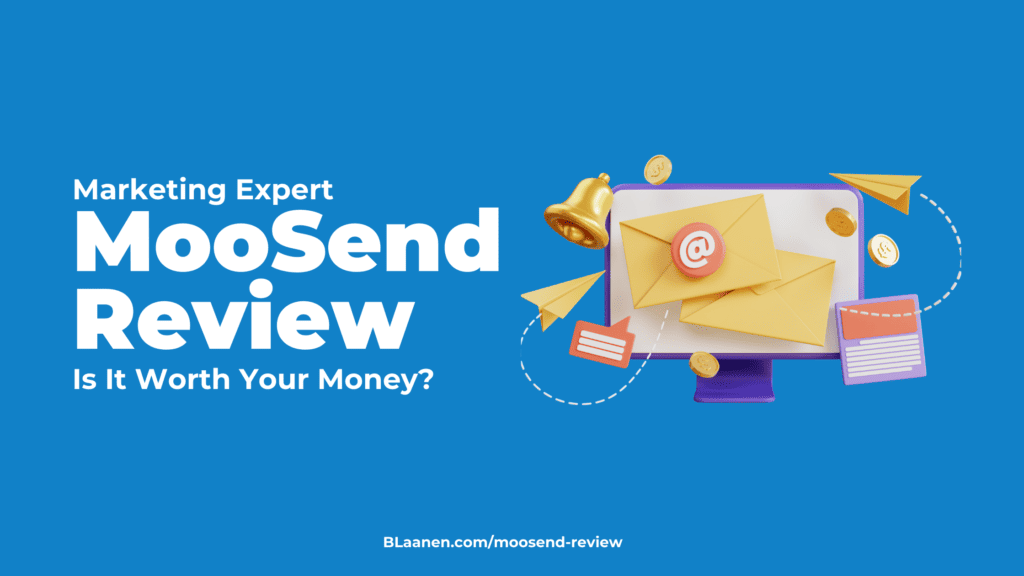There’s no doubt about it, my team and I are huge proponents of content marketing for small businesses focused on the long game.
When done correctly, content marketing can be a powerful tool for any small business owner looking to build visibility and attract new customers.
This expert guide provides a comprehensive overview of how to use content marketing for your small business. We’ll discuss the basics of content creation and distribution.
We’ll also walk through all the essential aspects you need to develop an effective small business content marketing strategy tailored specifically to your business.
Table of Contents
ToggleWhat is Content Marketing?
Content marketing for small businesses is the strategic process of creating and distributing valuable and relevant content. It aims to acquire, engage, and retain a clearly defined target audience to drive profitable customer action.
Benefits of Content Marketing for Small Businesses: Why Should You Do It?
Before getting into details, let’s see what a powerful content marketing strategy can offer small business owners:
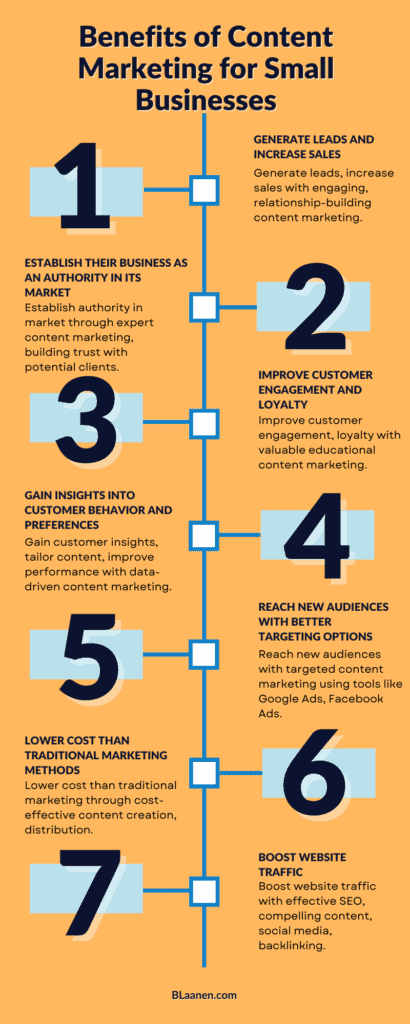
1. Generate Leads and Increase Sales
Creating interesting and informative content can draw people in and encourage them to interact with your business. This provides more opportunities for lead generation.
People already engaged are more likely to take action when they see a product or service they like.
With the right approach, small business content marketing:
- Engages new potential customers.
- Builds relationships.
- Creates trust.
2. Establish Their Business as an Authority in Its Market
Content marketing strategies allow you to present yourself as an expert in your industry. This helps build trust and credibility with potential clients.
When customers see that your business is well-versed in its field, they are more likely to trust your products or services.
You can become a source of reliable information for your customers through content marketing.
3. Improve Customer Engagement and Loyalty
Content marketing is all about producing content that will help further educate your customers and build relationships. Through the strategic use of online content, you can create a deeper level of engagement and loyalty with your customers.
For example, It’s best to create blog posts that provide valuable information about your products or services. Your customers will likely become loyal because they know you are helping them. This also sends the message that you offer high quality in everything you do, starting with the information you provide.
4. Gain Insights Into Customer Behavior and Preferences
Small business content marketing can be a great way to understand customer behavior and preferences. By analyzing the content your customers engage with, you can better understand:
- What they are interested in.
- How they interact with your business.
This information can help you create content tailored to their interests. As a result, it can lead to higher engagement rates and more conversions on your website.
You can gain valuable insights by monitoring the performance of each piece of content you create. These insights provide information on which types of content work best for your target audience. This allows you to focus on creating more of what works.
5. Reach New Audiences With Better Targeting Options
With content marketing for small businesses, it’s important to target the right people. You can do this by utilizing tools such as Google Ads, Facebook Ads, and other targeted platforms.
These help you reach a larger audience and find potential clients who are interested in what your business has to offer. With these targeting options, you’ll be able to get the most out of your content.
6. Lower Cost Than Traditional Marketing Methods
Content marketing can offer significant cost savings compared to traditional marketing methods. It also allows your business to create and distribute content with minimal expenses.
Content creation costs are usually low, and there are free or inexpensive ways to reach potential clients and fans.
7. Boost Website Traffic
A small business with a reliable content marketing strategy can highly benefit from a website traffic boost. To do this, you need to have effective SEO tactics in place. This includes:
- Optimizing your website for search engine algorithms.
- Creating compelling content that attracts visitors
- Using social media channels to promote your business and its content.
Building a backlinking system
Pro Tips for Implementing a Content Marketing Strategy
A content marketing strategy can be a powerful tool if implemented properly. Many business owners skip this part and wonder why they don’t get the expected results.
Here are some tips that keep you on the right track:
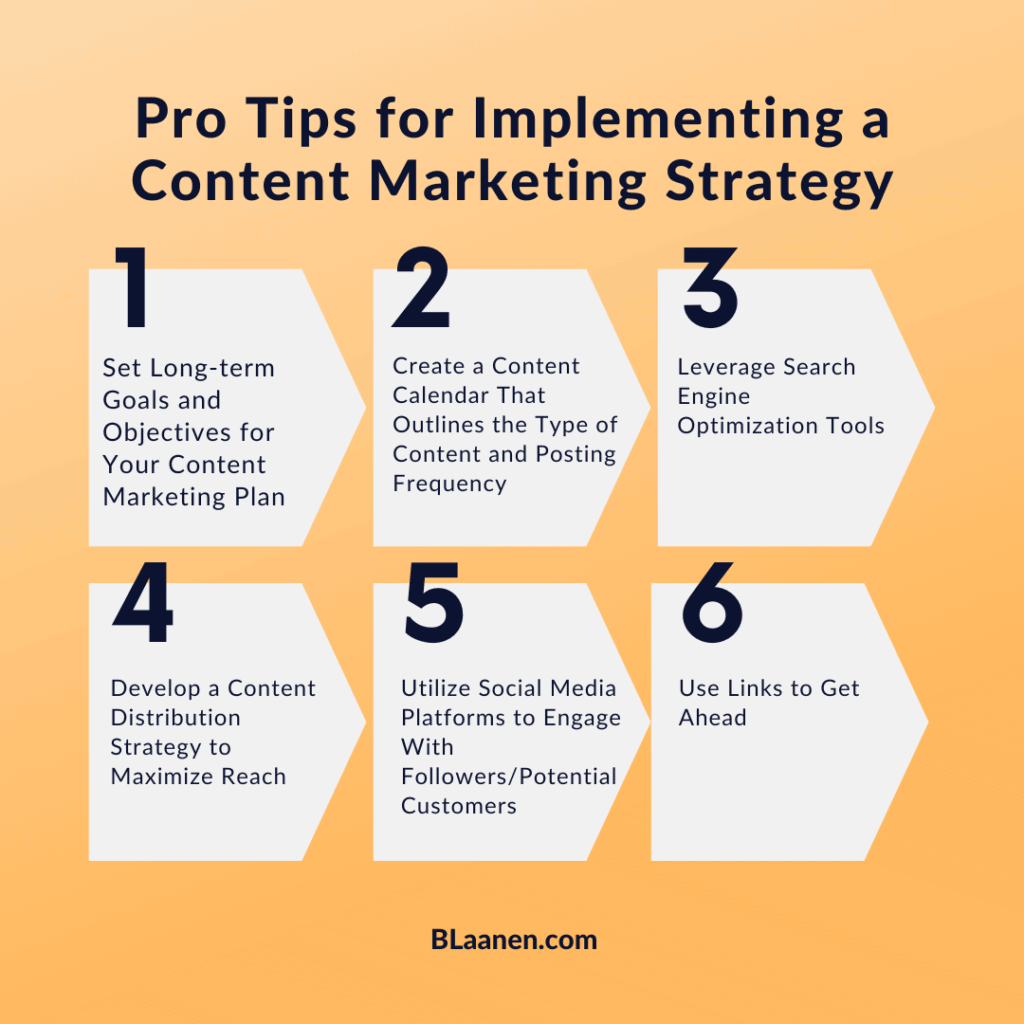
1. Set Long-term Goals and Objectives for Your Content Marketing Plan
When setting long-term goals and objectives for your content marketing strategy, it’s important to recognize the value of your content. Ask yourself: What am I trying to achieve with this content?
Your long-term goals should be clear and attainable. They should also include specific metrics that you can measure against—for example, a certain level of engagement or lead generation. Once your objectives are set, you can develop strategies and tactics to help you reach those goals.
It’s also important to establish a timeline for achieving these long-term goals. Consider when you want to see results and how often you will track progress toward them.
2. Create a Content Calendar That Outlines the Type of Content and Posting Frequency
When it comes to creating a content calendar, the first step is to outline the types of content you will create:
- Blog posts
- Videos
- Podcasts
- Infographics
- Case studies
- Newsletters
Be sure to list out all the possible types of content you plan on creating. This way, your calendar has a clear definition for each type.
Consider how often you want to publish content. This could be anywhere from daily updates or weekly posts. It depends on your goals and the resources available. Determine how often these pieces should be released to best reach and engage your target audience.
It’s also important to assign writers or other contributors who can take responsibility for content creation. This can help ensure that your content marketing calendar is on track and all issues are covered in time.
3. Leverage Search Engine Optimization Tools
Search engine optimization (SEO) is a great way to enhance visibility and rankings in organic search results. Leveraging SEO tools can help you focus your efforts on optimizing your blog post for the best possible results.
When creating content for your blog post, use relevant keywords. They will appear in organic search engine rankings when someone searches for related topics.
Be sure to include the primary keyword or phrase near the beginning of the article. Also, include it throughout the body of the text. This helps boost its relevance and visibility in organic search results.
Another way to leverage SEO tools is to ensure each page has unique meta titles and descriptions. Here are some tips to keep in mind:
- Meta titles and descriptions should be optimized with targeted keywords.
- Meta titles should be clear and concise and include the main keyword.
- Meta descriptions should be a summary of what the page is about.
When optimizing your blog post for organic search engine visibility and rankings, link to other relevant pages or websites. Linking out to external sources helps boost your credibility in organic search results. This makes it easier for people to find you. It will also help increase exposure for your content and drive more traffic to your website.
This table lists the most reliable SEO tools you can try for free:
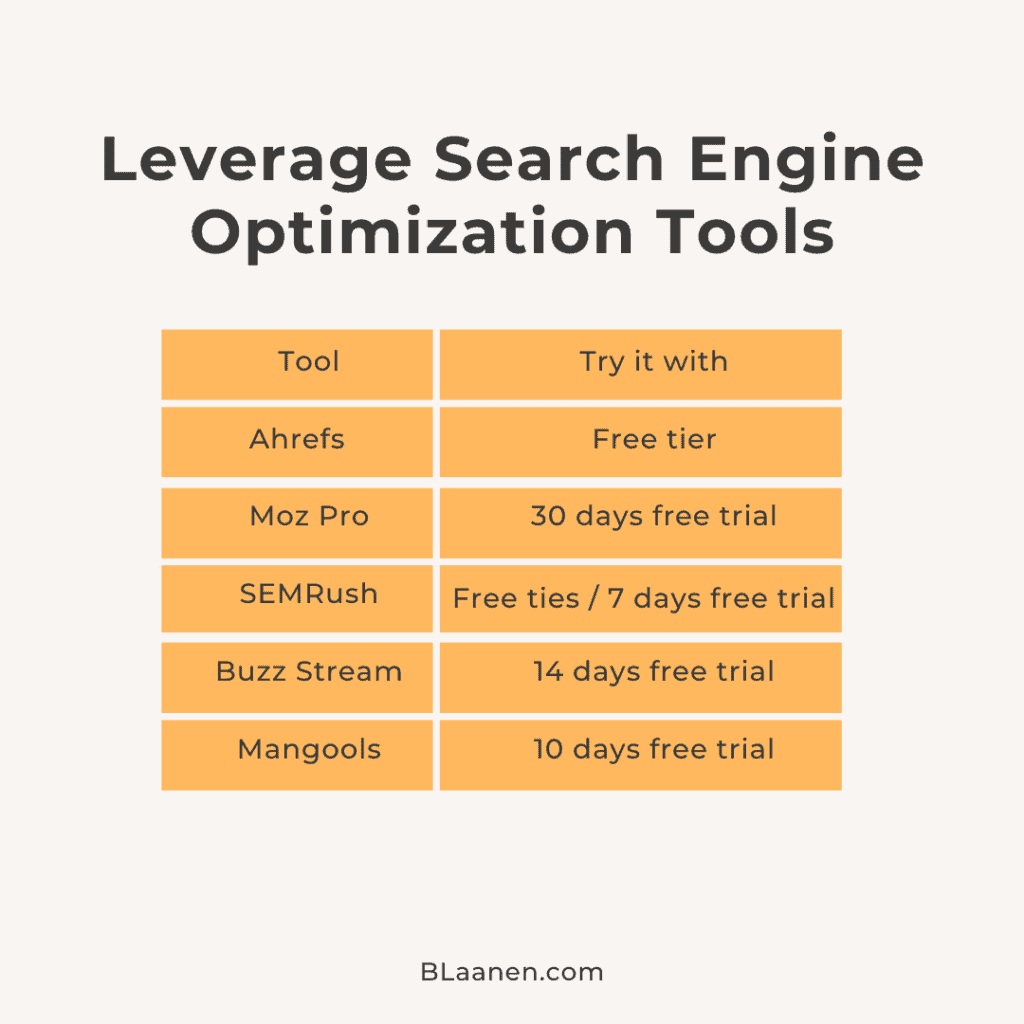
4. Develop a Content Distribution Strategy to Maximize Reach
Content marketing for a small business requires a comprehensive distribution strategy to maximize reach.
To start, make sure your content is accessible on all digital platforms:
- Social media platforms
- Search engines
- Email newsletters
You can also use local influencers or partnerships with other businesses to help get the word out about your content.
5. Utilize Social Media Platforms to Engage With Followers/Potential Customers
Social media platforms are incredibly useful for small businesses to engage with followers and potential clients.
By developing a strong social media presence, you can:
- Increase brand awareness.
- Interact with customers in real-time.
- Drive sales.
Start by creating engaging social media posts. These posts need to communicate your product or service and its value clearly. Make sure to:
- Use visuals (photos, videos, etc.) whenever possible to make sure your posts stand out in the news feed.
- Use hashtags related to your business and industry to reach more users who may share your content.
You should also respond promptly and professionally to comments or messages you receive on your social media platforms. This goes a long way in:
- Demonstrating the level of customer service you provide.
- Building a loyal following with potential customers.
6. Use Links to Get Ahead
Link building is the process of getting other websites to link back to yours. This helps your website’s search engine rankings because it signals that your content is trustworthy and valuable.
Link building also increases referral traffic from external sources, which can help boost brand awareness and generate leads.
The two most famous processes are:
- White hat link building: It builds organic links from websites with relevant content and provides more natural search engine optimization.
- HARO link building: It allows businesses to reach out to journalists and bloggers who need information for their stories. This allows them to create content with valuable backlinks included.
Content Marketing Tips for Small Businesses

1. Make Sure Everything Is Set Up Correctly
Before launching a content marketing strategy for a small business, make sure everything is set up correctly. This includes:
- Website
- SEO strategy
- Design
- Brand identity
- Conversion
- Follow-up strategies
- Optimized homepage
Website
When setting up the website for a small business, you should take care of the basics first:
- You need to obtain a hosting space.
- The domain name should suit the company’s goals.
- All technical requirements must be fulfilled.
- The website should be mobile-friendly.
If you plan on using email campaigns or growing your social media presence with an integrated blog or other content types, you need to make sure that the website is built for this purpose.
SEO Strategy
Take SEO into account when developing content for your business. Don’t skip:
- Titles and headings
- Content optimization
- Other technical components
All of these should be optimized with the target audience in mind. As a result, the content will reach its maximum potential in terms of search engine visibility.
Design
The design plays an important role as well. It needs to be both professional and appealing. It should give users an excellent first impression and create trust from the start:
- The colors should reflect your company’s personality and mission statement.
- The fonts should help enhance readability.
Brand Identity
Creating a strong brand identity is key to building customer loyalty. Your unique logo, slogan, and design elements should represent the company’s vision. The content itself needs to communicate what the business stands for. It should also make customers feel connected to it.
Conversion Strategies
It is also important to consider conversion strategies when developing content for a small business. This includes crafting compelling calls-to-action that entice visitors to take action, such as:
- Signing up for a newsletter.
- Making an online purchase.
- Contracting your services.
Homepage
Your homepage should be optimized for conversions. Make sure to incorporate clear messaging about:
- Who you are.
- What you do.
- What the customer should do next (call-to-action button).
Any promotional materials or seasonal offers should be featured on this page to maximize conversions.
Follow-up Strategies
Follow-up strategies must be implemented to ensure that customers keep coming back for more. This involves:
- Sending out automated emails with personalized content.
- Setting up a loyalty program where customers earn rewards when they complete specific actions.
2. Determine the Type of Content Suited for Your Business
It’s important to determine the best-suited type of content for your business.
Blog posts are a great place to start, as they provide a platform for:
- Connecting with audiences.
- Sharing stories.
- Promoting products or services.
When creating content, it is essential to consider the needs of your target audience. Go through how you can create compelling and engaging content that resonates with them. Consider:
- Researching keywords related to your industry
- Interviewing customers
- Leveraging customer stories
This allows you to craft meaningful content.
If you feel overwhelmed, you can reach out for help from others, such as professionals, such as my team and I, that specialize in creating content tailored specifically for small businesses.
Don’t forget to promote your content:
- Share it through social media channels.
- Submit it to directories.
- Create paid campaigns via Google Ads or other platforms to reach new audiences.
3. Focus On Your Niche
When implementing a content marketing strategy, a business must focus on its niche. Focusing on your niche allows you to create quality content tailored to your customers.
You need to create quality content that is relevant to your industry and showcase it creatively. This helps you distinguish yourself from the competition and present yourself as an authority within the field.
When focusing on your niche, it’s important to ensure that all created content provides value and educates readers about topics related to your industry.
Quality content will not only help keep readers engaged. It will also build trust with prospects, resulting in more conversions and sales.
Providing unique perspectives through blog posts or videos gives viewers an inside look into the industry. It also broadens the reach of your brand.
Exploring topics related to current trends creates timely and relevant content, encouraging viewers to come back for more.
4. Focus on Your Target Audience
When developing a small business content marketing strategy, it is essential to identify and focus on the needs of your customers.
You can better understand the interests of your customers and create valuable content that speaks directly to them by:
- Using tools such as Google Analytics
- Researching industry trends
Content should be created with an understanding of who it is targeting and what they need from it.
You can use data-driven insights to track how readers engage with your content and adjust accordingly. This will help you refine your strategies and target specific groups with more relevant solutions.
5. Tell a Story (Brand Storytelling)
Good storytelling is how you emotionally connect with your customers. It helps create a strong identity and reputation for your business. All this while helping you boost recognition and loyalty among your customer base. When done properly, it can be a powerful tool. It creates valuable content that resonates with your target audience.
Great brand storytelling involves more than just telling stories. It also includes understanding what makes those stories unique and meaningful to your audience.
Trigger a Feeling
It’s important to focus on adding some key elements to the stories you tell:
- Emotion
- Humor
- Adventure
- Inspiration
Awakening a strong feeling is essential for any story you tell to be impactful. You want your stories to reflect your brand’s core values and mission statement. You also want to build relationships and trust with potential customers.
The Importance of Adding Visuals
Incorporating visuals into the stories helps create vivid memories. People remember pictures better than they do words. This is called the picture superiority effect. Vivid stories are easier for readers or viewers to follow. Use:
- Photographs
- Illustrations
- Videos
- Infographics
Visuals give the story more life and keep people engaged throughout the entire piece.
Share Info from Behind the Scene
Providing information from behind the scenes can make the content personal. This satisfies customers’ curiosity and gives them a sense of engagement. You reveal company secrets or processes which no one else knows about.
Here is what you can do if you are selling a product online:
Explain how it is made.
Describe the process from start to finish.
Share stories about the people involved in its production.
Doing this gives customers an insight into your business that they may otherwise not have had access to.
The more details and information you provide, the better. This helps foster trust between your brand and customers. It also demonstrates transparency.
6. Don’t Bring up General Content, Be Specific
When it comes to content marketing, quality and relevance are key. Delivering high-quality and relevant content is essential for successful content marketing campaigns.
Focus on specific, detailed information rather than general ideas or concepts. This allows you to ensure that your content will be well received by readers. High-quality content should include:
- Valuable insights
- Unique information
- Meaningful stories that your audience can relate to
7. Do Thorough Research
Whether writing blog content or creating a comprehensive content strategy, you should conduct thorough research beforehand. This ensures that the content generated is accurate and effective. Creating quality content for small businesses is essential to success, as it can help a business reach a wider audience.
When researching for blog content:
- Make sure to check sources from reputable outlets.
- Double-check information for accuracy.
- Consider looking into industry trends that could help inform your writing.
When creating a larger-scale content strategy, conducting surveys with customers or potential customers can provide valuable insight. This insight can be related to what customers want or need from the product/service you offer.
Doing some competitive analysis may also be beneficial when assessing gaps in the market.
8. Repurpose Old Content
Content repurposing is the process of taking existing content and transforming it into something new. You can do this in a variety of ways:
- Break down old blog posts into infographics.
- Turn them into listicles or slideshows.
- Create an eBook out of a series of related blog posts.
The advantage of repurposing content is that it saves time and resources while keeping your content relevant and up-to-date over time.
9. Measure Your Performance
Key Performance Indicators (KPIs) are metrics used to measure the success of a content strategy. Tracking these metrics helps marketers analyze their performance and optimize content for better results.
To measure performance effectively, you must have a clearly defined audience in mind. Aligning KPIs with that specific audience’s needs is essential.
Commonly used KPIs include:
- Monitory metrics such as return on investment (ROI)
- Sales conversion rate
- Keyword ranking
- Click-through rate
- Website traffic
- Customer engagement rate
- Email signups and time on the page
Non-monetary indicators like brand awareness and customer sentiment can also be tracked through surveys and other qualitative data sources.
Common Mistakes When Implementing a Small Business Content Marketing Plan
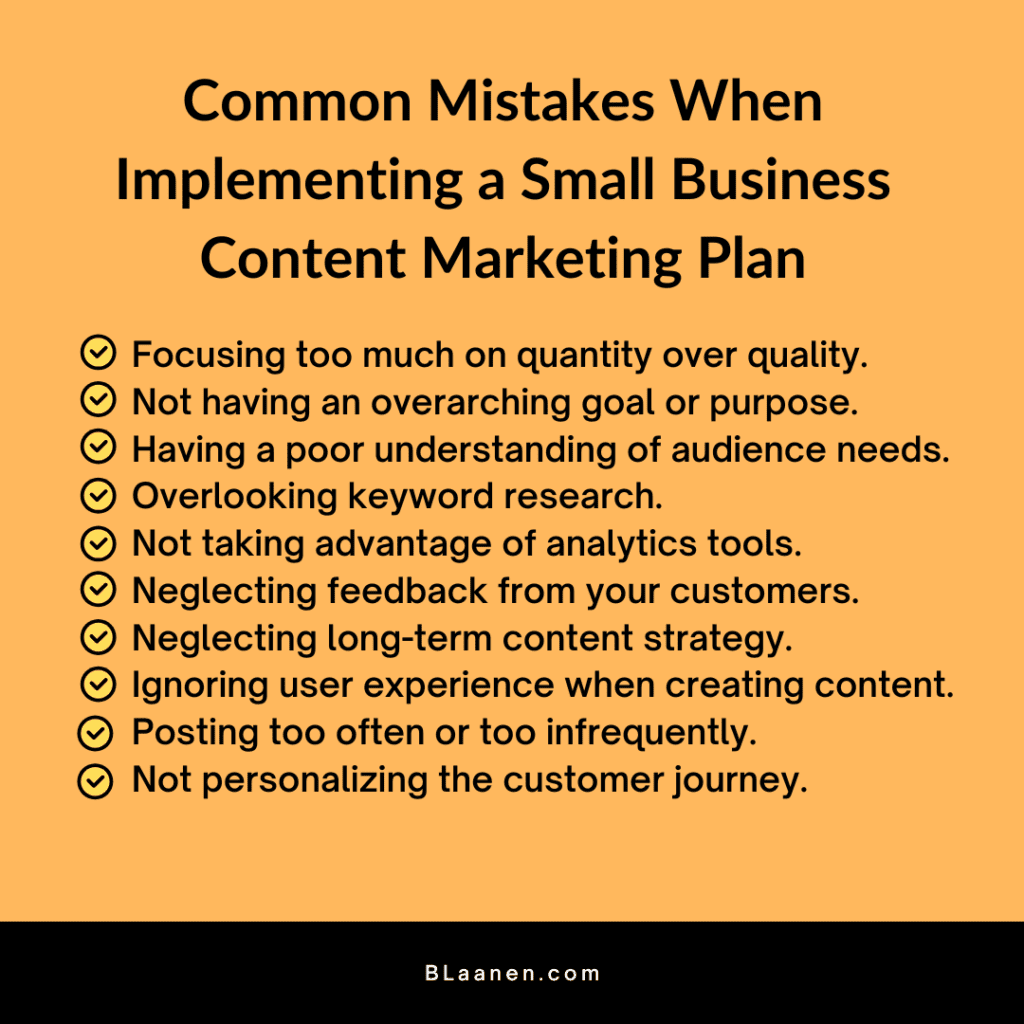
Content marketing for a small business differs between brands and, most importantly, differs from what big companies need to do. Still, there are some key factors that, when ignored, can damage your small business content marketing efforts:
- Focusing too much on quantity over quality
- Not having an overarching goal or purpose
- Having a poor understanding of audience needs
- Overlooking keyword research
- Not taking advantage of analytics tools
- Neglecting feedback from your customers
- Neglecting long-term content strategy
- Ignoring user experience when creating content
- Posting too often or too infrequently
- Not personalizing the customer journey
Final Thoughts
Content marketing is a great way for small businesses to improve their online visibility and reach more customers. Small businesses can build trust with potential and current customers by creating high-quality, informative content.
Implementing content marketing ideas for small businesses doesn’t have to be complicated or time-consuming. There are plenty of easy ways to get started. If you need help getting your content marketing efforts off the ground, we’re happy to offer our expertise.
BLaanen is a conversion-focused content marketing agency, and we can help you create an effective content marketing strategy. Want to have a chat? Get in touch with Blaanen.


